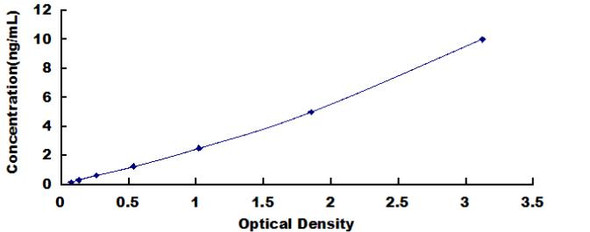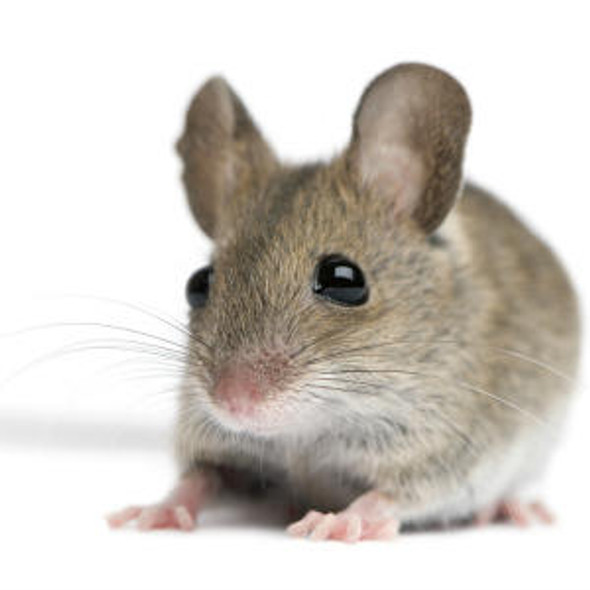Mouse Cell Death ELISA Kits
Mouse ERN1 (Endoplasmic Reticulum To Nucleus Signalling 1) CLIA Kit (MOES00239)
- SKU:
- MOES00239
- Product Type:
- ELISA Kit
- ELISA Type:
- CLIA Kit
- Size:
- 96 Assays
- Sensitivity:
- 7.5pg/mL
- Range:
- 12.5-800pg/mL
- ELISA Type:
- Sandwich
- Reactivity:
- Mouse
- Sample Type:
- Serum, plasma and other biological fluids
- Research Area:
- Cell Death
Description
| Assay type: | Sandwich |
| Format: | 96T |
| Assay time: | 4.5h |
| Reactivity: | Mouse |
| Detection method: | Chemiluminescence |
| Detection range: | 12.50-800 pg/mL |
| Sensitivity: | 7.50 pg/mL |
| Sample volume: | 100µL |
| Sample type: | Serum, plasma and other biological fluids |
| Repeatability: | CV < 15% |
| Specificity: | This kit recognizes Mouse ERN1 in samples. No significant cross-reactivity or interference between Mouse ERN1 and analogues was observed. |
This kit uses Sandwich-CLIA as the method. The micro CLIA plate provided in this kit has been pre-coated with an antibody specific to Mouse ERN1. Standards or samples are added to the appropriate micro CLIA plate wells and combined with the specific antibody. Then a biotinylated detection antibody specific for Mouse ERN1 and Avidin-Horseradish Peroxidase (HRP) conjugate are added to each micro plate well successively and incubated. Free components are washed away. The substrate solution is added to each well. Only those wells that contain Mouse ERN1, biotinylated detection antibody and Avidin-HRP conjugate will appear fluorescence. The Relative light unit (RLU) value is measured spectrophotometrically by the Chemiluminescence immunoassay analyzer. The RLU value is positively associated with the concentration of Mouse ERN1. The concentration of Mouse ERN1 in the samples can be calculated by comparing the RLU of the samples to the standard curve.
| UniProt Protein Function: | IRE1: a ser/thr protein kinase that possess endonuclease activity. Important in altering gene expression as a response to endoplasmic reticulum based stress signals. Senses unfolded proteins in the lumen of the endoplasmic reticulum via its N-terminal domain, which leads to enzyme auto-activation. The active endoribonuclease domain splices XBP1 mRNA to generate a new C-terminus, converting it into a potent unfolded-protein response transcriptional activator and triggering growth arrest and apoptosis. The kinase domain is activated by trans-autophosphorylation. Kinase activity is required for activation of the endoribonuclease domain. Ubiquitously expressed. High levels observed in pancreatic tissue. Functionally connected with insulin biosynthesis in pancreatic beta cells. Homodimer; disulfide-linked. Dimer formation is driven by hydrophobic interactions within the N-terminal luminal domains and stabilized by disulfide bridges. Also binds HSPA5, a negative regulator of the unfolded protein response. This interaction may disrupt homodimerization and prevent activation of IRE1. |
| UniProt Protein Details: | Protein type:Kinase, protein; Chaperone; Membrane protein, integral; Apoptosis; EC 2. 7. 11. 1; Endoplasmic reticulum; Ribonuclease; Protein kinase, Ser/Thr (non-receptor); Protein kinase, Other; Other group; IRE family Cellular Component: cytoplasm; endoplasmic reticulum; endoplasmic reticulum membrane; integral to endoplasmic reticulum membrane; mitochondrion; nuclear inner membrane Molecular Function:ADP binding; ATP binding; endonuclease activity; endoribonuclease activity; enzyme binding; Hsp70 protein binding; Hsp90 protein binding; identical protein binding; magnesium ion binding; protein binding; protein homodimerization activity; protein serine/threonine kinase activity Biological Process: activation of JNK activity; cell cycle arrest; endothelial cell proliferation; mRNA cleavage; positive regulation of RNA splicing; protein amino acid autophosphorylation; protein amino acid phosphorylation; unfolded protein response; unfolded protein response, activation of signaling protein activity |
| UniProt Code: | Q9EQY0 |
| NCBI GenInfo Identifier: | 51316086 |
| NCBI Gene ID: | 78943 |
| NCBI Accession: | Q9EQY0. 1 |
| UniProt Secondary Accession: | Q9EQY0,Q9D340, |
| UniProt Related Accession: | Q9EQY0 |
| Molecular Weight: | 45,303 Da |
| NCBI Full Name: | Serine/threonine-protein kinase/endoribonuclease IRE1 |
| NCBI Synonym Full Names: | endoplasmic reticulum (ER) to nucleus signalling 1 |
| NCBI Official Symbol: | Ern1 |
| NCBI Official Synonym Symbols: | Ire1a; Ire1p; C85377; AI225830; Ire1alpha; 9030414B18Rik |
| NCBI Protein Information: | serine/threonine-protein kinase/endoribonuclease IRE1 |
| UniProt Protein Name: | Serine/threonine-protein kinase/endoribonuclease IRE1 |
| UniProt Synonym Protein Names: | Endoplasmic reticulum-to-nucleus signaling 1; Inositol-requiring protein 1; Ire1-alpha; IRE1a |
| UniProt Gene Name: | Ern1 |
| UniProt Entry Name: | ERN1_MOUSE |
As the RLU values of the standard curve may vary according to the conditions of the actual assay performance (e. g. operator, pipetting technique, washing technique or temperature effects), the operator should establish a standard curve for each test. Typical standard curve and data is provided below for reference only.
| Concentration (pg/mL) | RLU | Average | Corrected |
| 800 | 47597 57687 | 52642 | 52616 |
| 400 | 21383 22085 | 21734 | 21708 |
| 200 | 10198 9218 | 9708 | 9682 |
| 100 | 4485 4619 | 4552 | 4526 |
| 50 | 2274 2102 | 2188 | 2162 |
| 25 | 1062 1058 | 1060 | 1034 |
| 12.50 | 478 540 | 509 | 483 |
| 0 | 26 26 | 26 | -- |
Precision
Intra-assay Precision (Precision within an assay): 3 samples with low, mid range and high level Mouse ERN1 were tested 20 times on one plate, respectively.
Inter-assay Precision (Precision between assays): 3 samples with low, mid range and high level Mouse ERN1 were tested on 3 different plates, 20 replicates in each plate.
| Intra-assay Precision | Inter-assay Precision | |||||
| Sample | 1 | 2 | 3 | 1 | 2 | 3 |
| n | 20 | 20 | 20 | 20 | 20 | 20 |
| Mean (pg/mL) | 37.71 | 96.90 | 360.85 | 36.78 | 88.86 | 357.73 |
| Standard deviation | 4.65 | 8.43 | 28.83 | 4.74 | 8.86 | 34.81 |
| C V (%) | 12.33 | 8.70 | 7.99 | 12.89 | 9.97 | 9.73 |
Recovery
The recovery of Mouse ERN1 spiked at three different levels in samples throughout the range of the assay was evaluated in various matrices.
| Sample Type | Range (%) | Average Recovery (%) |
| Serum (n=5) | 97-115 | 105 |
| EDTA plasma (n=5) | 89-102 | 96 |
| Cell culture media (n=5) | 86-99 | 92 |
Linearity
Samples were spiked with high concentrations of Mouse ERN1 and diluted with Reference Standard & Sample Diluent to produce samples with values within the range of the assay.
| Serum (n=5) | EDTA plasma (n=5) | Cell culture media (n=5) | ||
| 1:2 | Range (%) | 89-101 | 90-101 | 95-109 |
| Average (%) | 94 | 96 | 103 | |
| 1:4 | Range (%) | 95-107 | 87-100 | 93-107 |
| Average (%) | 102 | 92 | 100 | |
| 1:8 | Range (%) | 101-115 | 91-105 | 103-120 |
| Average (%) | 108 | 98 | 109 | |
| 1:16 | Range (%) | 89-105 | 88-100 | 93-109 |
| Average (%) | 96 | 94 | 99 |
An unopened kit can be stored at 4°C for 1 month. If the kit is not used within 1 month, store the items separately according to the following conditions once the kit is received.
| Item | Specifications | Storage |
| Micro CLIA Plate(Dismountable) | 8 wells ×12 strips | -20°C, 6 months |
| Reference Standard | 2 vials | |
| Concentrated Biotinylated Detection Ab (100×) | 1 vial, 120 µL | |
| Concentrated HRP Conjugate (100×) | 1 vial, 120 µL | -20°C(shading light), 6 months |
| Reference Standard & Sample Diluent | 1 vial, 20 mL | 4°C, 6 months |
| Biotinylated Detection Ab Diluent | 1 vial, 14 mL | |
| HRP Conjugate Diluent | 1 vial, 14 mL | |
| Concentrated Wash Buffer (25×) | 1 vial, 30 mL | |
| Substrate Reagent A | 1 vial, 5 mL | 4°C (shading light) |
| Substrate Reagent B | 1 vial, 5 mL | 4°C (shading light) |
| Plate Sealer | 5 pieces | |
| Product Description | 1 copy | |
| Certificate of Analysis | 1 copy |
- Set standard, test sample and control (zero) wells on the pre-coated plate and record theirpositions. It is recommended to measure each standard and sample in duplicate. Note: addall solutions to the bottom of the plate wells while avoiding contact with the well walls. Ensuresolutions do not foam when adding to the wells.
- Aliquot 100µl of standard solutions into the standard wells.
- Add 100µl of Sample / Standard dilution buffer into the control (zero) well.
- Add 100µl of properly diluted sample (serum, plasma, tissue homogenates and otherbiological fluids. ) into test sample wells.
- Cover the plate with the sealer provided in the kit and incubate for 90 min at 37°C.
- Aspirate the liquid from each well, do not wash. Immediately add 100µL of BiotinylatedDetection Ab working solution to each well. Cover the plate with a plate seal and gently mix. Incubate for 1 hour at 37°C.
- Aspirate or decant the solution from the plate and add 350µL of wash buffer to each welland incubate for 1-2 minutes at room temperature. Aspirate the solution from each well andclap the plate on absorbent filter paper to dry. Repeat this process 3 times. Note: a microplatewasher can be used in this step and other wash steps.
- Add 100µL of HRP Conjugate working solution to each well. Cover with a plate seal andincubate for 30 min at 37°C.
- Aspirate or decant the solution from each well. Repeat the wash process for five times asconducted in step 7.
- Add 100µL of Substrate mixture solution to each well. Cover with a new plate seal andincubate for no more than 5 min at 37°C. Protect the plate from light.
- Determine the RLU value of each well immediately.






